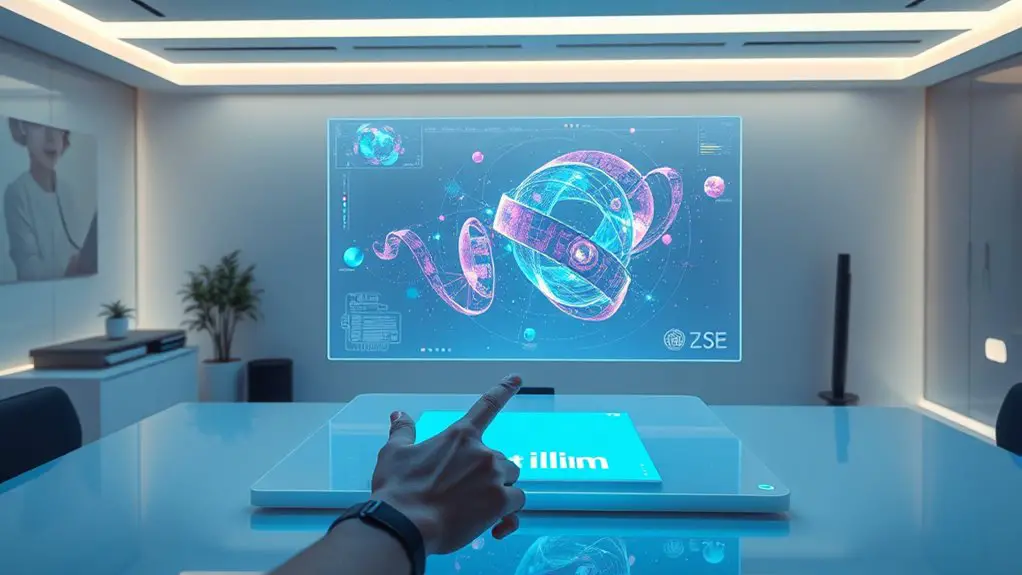Spatial computing blends the digital and physical worlds, changing how you engage with technology. It provides immersive experiences through intuitive interfaces and real-time data visualization, enhancing spatial awareness. As display technology evolves, it offers high-resolution screens and interactive holography, pushing the limits of visual quality. This transformation aims for environments where you feel present and connected. There's so much more to explore about these advancements and their growing influence on various industries.
Understanding Spatial Computing
Spatial computing represents a revolutionary intersection of the digital and physical worlds, transforming how we interact with technology. It enhances your spatial awareness, allowing you to perceive and engage with your environment in novel ways. By integrating digital elements into your physical surroundings, spatial computing creates immersive experiences that feel both natural and intuitive. You can visualize data in real-time, interact with 3D models, and navigate virtual landscapes as if they were part of your world. This technology challenges traditional boundaries, granting you the freedom to explore, learn, and create in ways previously unimaginable. As spatial computing evolves, it promises to redefine how you connect with technology, making each interaction more meaningful and dynamic.
The Technology Behind Spatial Computing
At the core of spatial computing lies a sophisticated blend of technologies that work together to create seamless interactions between the digital and physical domains. You'll find that spatial interfaces play a vital role, allowing users to engage with digital content naturally and intuitively. These interfaces are designed for immersive environments that enhance your experience, making virtual elements feel like an extension of your reality. Interactive holography takes this a step further, enabling 3D visuals to come alive in your space. Furthermore, real-time rendering guarantees that these experiences remain fluid and responsive, adapting to your movements and actions. Together, these technologies empower you to explore and interact with digital landscapes, offering a newfound sense of freedom in how you perceive and engage with the world around you.
Applications of Spatial Computing in Various Industries
The rise of spatial computing is transforming industries in remarkable ways, reshaping how businesses operate and engage with their audiences. In healthcare applications, this technology enables precise surgeries and remote consultations, enhancing patient care considerably. Retail experiences are evolving too, with immersive shopping environments that allow customers to visualize products in their own space before making a purchase. Education tools are becoming more interactive, offering students hands-on learning through augmented reality, making complex concepts accessible and engaging. Meanwhile, entertainment enhancements are taking storytelling to new dimensions, creating immersive worlds that captivate audiences like never before. By integrating spatial computing, industries are not just enhancing their offerings; they're redefining the very essence of user experience and engagement.
The Evolution of Display Technology in the Age of Spatial Computing
As industries embrace spatial computing, display technology is undergoing a significant transformation to meet new demands for immersive experiences. You're witnessing display advancements that not only enhance visual quality but also integrate seamlessly with augmented and virtual environments. High-resolution screens, flexible displays, and 3D holographic projections are redefining how you interact with digital content. These innovations allow for a more natural interface, breaking the barriers between the physical and digital worlds. Additionally, adaptive displays respond to user behaviors, creating personalized experiences that resonate deeply. The drive for more engaging visuals isn't just about aesthetics; it's about creating environments where you feel truly present. As this evolution continues, expect display technology to push the limits of what's possible, enriching your spatial computing journey.
Future Trends and Innovations in Spatial Computing and Display Technology
With display technology rapidly evolving to support immersive experiences, future trends are set to revolutionize how you engage with digital content in spatial computing. Augmented reality (AR) will become more prevalent, blending your physical and digital worlds seamlessly. Expect more sophisticated interactive interfaces that respond intuitively to your movements and gestures, enhancing your ability to navigate virtual environments. As hardware advances, you'll find displays that offer higher resolutions and wider fields of view, making immersive experiences feel more lifelike. Additionally, advancements in haptic feedback will allow you to 'feel' these environments, adding another layer of realism. These innovations promise to redefine your interaction with technology, granting you unprecedented freedom to explore and create in ways you never thought possible.
Frequently Asked Questions
How Does Spatial Computing Affect User Privacy and Data Security?
Did you know that 79% of users worry about privacy in tech? With spatial computing, user consent becomes essential, and robust data encryption is necessary to protect sensitive information, ensuring your data remains secure in immersive environments.
What Skills Are Needed to Work in Spatial Computing Fields?
To thrive in spatial computing, you'll need skills in software development, a keen understanding of user experience, and the ability to adapt to emerging technologies. Embracing creativity and analytical thinking will further enhance your potential in this field.
Are There Any Health Risks Associated With Spatial Computing Technologies?
When exploring spatial computing, you might face eye strain, motion sickness, and cognitive overload. You could also encounter social isolation and ergonomic concerns, which may lead to long-term effects on your health and well-being.
How Can Small Businesses Leverage Spatial Computing Effectively?
You can leverage virtual reality and augmented reality by enhancing customer experiences, creating immersive marketing campaigns, and providing virtual product demonstrations. These tools can set your small business apart and foster deeper connections with your audience.
What Are the Environmental Impacts of Spatial Computing Devices?
You should consider the environmental impacts of spatial computing devices, including their energy consumption and the importance of recycling initiatives. Reducing waste and optimizing energy use can enhance sustainability while benefiting your business and the planet.

